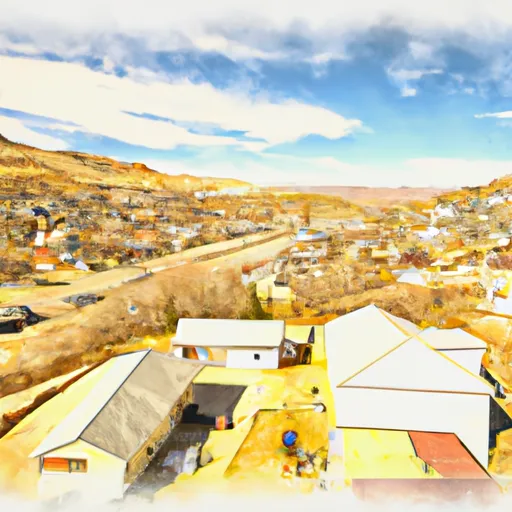-
 Snoflo Premium
Snoflo Premium
Get unlimited access to all our content
With no Ad interruptions! - Start Your Free Trial Login with existing account
Teasdale
Eden Index
Climate
7.4
•
Recreation
5.1
•
Community
•
Safeguard
4.7/10

Teasdale, Utah is a small town located in the southern part of the state near Capitol Reef National Park. The climate in Teasdale is classified as a semi-arid desert climate, with hot summers and cold winters. Summers typically see high temperatures averaging around 90°F (32°C), while winter temperatures can drop below freezing. Precipitation is relatively low, with most of it occurring during the winter months in the form of snow.
Hydrologically, Teasdale is situated near the Fremont River, which flows nearby and provides water for irrigation purposes. The river also supports a variety of wildlife and vegetation in the area.
As for outdoor recreation, Teasdale offers several opportunities for nature enthusiasts. Capitol Reef National Park is just a short drive away, where visitors can explore scenic canyons, sandstone cliffs, and ancient petroglyphs. The park also offers hiking trails, camping sites, and opportunities for rock climbing. Additionally, the nearby Boulder Mountain provides excellent fishing spots, with several lakes and streams teeming with trout. Overall, Teasdale is a great destination for those looking to immerse themselves in the stunning natural beauty of southern Utah.
What is the Eden Index?
The Snoflo Eden Index serves as a comprehensive rating system for regions, evaluating their desirability through a holistic assessment of climate health, outdoor recreation opportunities, and natural disaster risk, acknowledging the profound impact of these factors on livability and well-being.
Climate Health Indicator (CHI): 7.4
Teasdale receives approximately
322mm of rain per year,
with humidity levels near 60%
and air temperatures averaging around
7°C.
Teasdale has a plant hardyness factor of
6, meaning
plants and agriculture in this region thrive during a short period during spring and early summer. Most
plants will die off during the colder winter months.
By considering the ideal temperature range, reliable water supplies, clean air, and stable seasonal rain or snowpacks, the Climate Health Indicator (CHI) underscores the significance of a healthy climate as the foundation for quality living.
A healthy climate is paramount for ensuring a high quality of life and livability in a region, fostering both physical well-being and environmental harmony. This can be characterized by ideal temperatures, reliable access to water supplies, clean air, and consistent seasonal rain or snowpacks.
Weather Forecast
Streamflow Conditions
Upper Colorado-Dirty Devil
Area Rivers
Upper Colorado-Dirty Devil
Snowpack Depths
Upper Colorado-Dirty Devil
Reservoir Storage Capacity
Upper Colorado-Dirty Devil
Groundwater Levels
Recreational Opportunity Index (ROI): 5.1
The Recreational Opportunity Index (ROI) recognizes the value of outdoor recreational options, such as parks, hiking trails, camping sites, and fishing spots, while acknowledging that climate plays a pivotal role in ensuring the comfort and consistency of these experiences.
Access to outdoor recreational opportunities, encompassing activities such as parks, hiking, camping, and fishing, is crucial for overall well-being, and the climate plays a pivotal role in enabling and enhancing these experiences, ensuring that individuals can engage in nature-based activities comfortably and consistently.
Camping Areas
| Campground | Campsites | Reservations | Toilets | Showers | Elevation |
|---|---|---|---|---|---|
| Pleasant Creek | 30 | 8,670 ft | |||
| Steep Creek Bench - Burr Trail Rd - Grand Staircase Nat Mon | None | 5,923 ft | |||
| Sunglow | 5 | 7,252 ft | |||
| Posy Lake | 22 | 8,716 ft | |||
| Durffey Mesa Dispersed - Burr Trail Rd - Grand Staircase Nat Mon | None | 5,832 ft | |||
| Elkhorn | 6 | 9,809 ft | |||
| Mallard Bay Overflow | 30 | 8,844 ft | |||
| Singletree | 27 | 8,286 ft | |||
| Cathedral Valley - Capitol Reef National Park | 6 | 6,923 ft | |||
| Blue Spruce | 6 | 8,019 ft |
Nearby Ski Areas
Catastrophe Safeguard Index (CSI):
The Catastrophe Safeguard Index (CSI) recognizes that natural disaster risk, encompassing floods, fires, hurricanes, and tornadoes, can drastically affect safety and the overall appeal of an area.
The level of natural disaster risk in a region significantly affects safety and the overall livability, with climate change amplifying these risks by potentially increasing the frequency and intensity of events like floods, fires, hurricanes, and tornadoes, thereby posing substantial challenges to community resilience and well-being.
Community Resilience Indicator (CRI):
The Community Resilience Indicator (CRI) recognizes that education, healthcare, and socioeconomics are crucial to the well-being of a region. The CRI acknowledges the profound impact of these elements on residents' overall quality of life. By evaluating educational resources, healthcare accessibility, and economic inclusivity, the index captures the essential aspects that contribute to a thriving community, fostering resident satisfaction, equity, and social cohesion.

